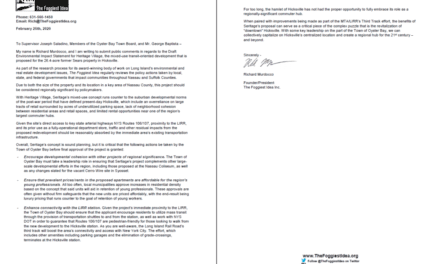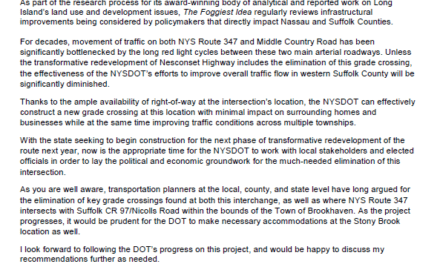The following was sent on 3/28/13 in response to New York State’s call for public input on the Cleaner, Greener Communities Plan for Long Island. It was submitted via the State’s online comment portal.
Hello,
My name is Richard Murdocco, and I am writing to provide public feedback on the Cleaner, Greener Community Plan for Long Island. I have my BA from Fordham University in both Urban Studies and Political Science, and my MA from SUNY Stony Brook in Public Policy, where I studied Regional Planning with my mentor, Dr. Lee Koppelman, Long Island’s veteran Planner. I work for a regional nonprofit in Suffolk County, and on the side to my professional position, I write regularly on land use issues, with my work appearing in Newsday, the Long Island Business News and other various print, online and television sources.
The Cleaner, Greener Plan is a step in the right direction, but I sincerely feel that it does not go far enough in addressing the regional needs of Long Island. The plan, in its current iteration, touts:
“The community representatives that have participated in this planning undertaking have made clear that Long Islanders value their unique community characteristics and are committed to self-governance under the local home rule system.”
I disagree with this approach. While residents want local control, the breadth of Long Island’s environmental issues must be dealt with not piecemeal and locally, but comprehensively on a regional scale. This is an environmental plan, a plan of which the recommendations are meant to be based upon the best available scientific data, not a home-grown community plan that is publicly nurtured.
It is crucial that any planning effort is driven from the public, and I applaud the efforts of the state to solicit public input via an online portal, but the localized approach is not correct for an environmental protection plan. I do feel however, that it is imperative for policymakers to go out across Nassau and Suffolk and solicit public input and recommendations from residents across the Island. Further, participation should not be sought from policy insiders, but the broader, general public once scientific recommendations are made.
Long Island, and Suffolk County in particular, has a long-legacy of nationally significant environmental planning efforts that can serve as the groundwork of this effort. It is critical that planners and the state take a look at these past efforts (Both the 1978 208 Study, the 1992 Special Groundwater Protection Area Plan set the standard for aquifer protection) and build from the foundation previously set.
Long Island’s challenges are unique, and our planning efforts to address them must be predicated upon sound scientific data that allows for policy recommendations that are both realistic and fully implementable. The worst-case scenario is another comprehensive, regional planning effort is produced that eventually gathers dust on a shelf. We, as a region, deserve better.
Thank you-
Richard Murdocco












